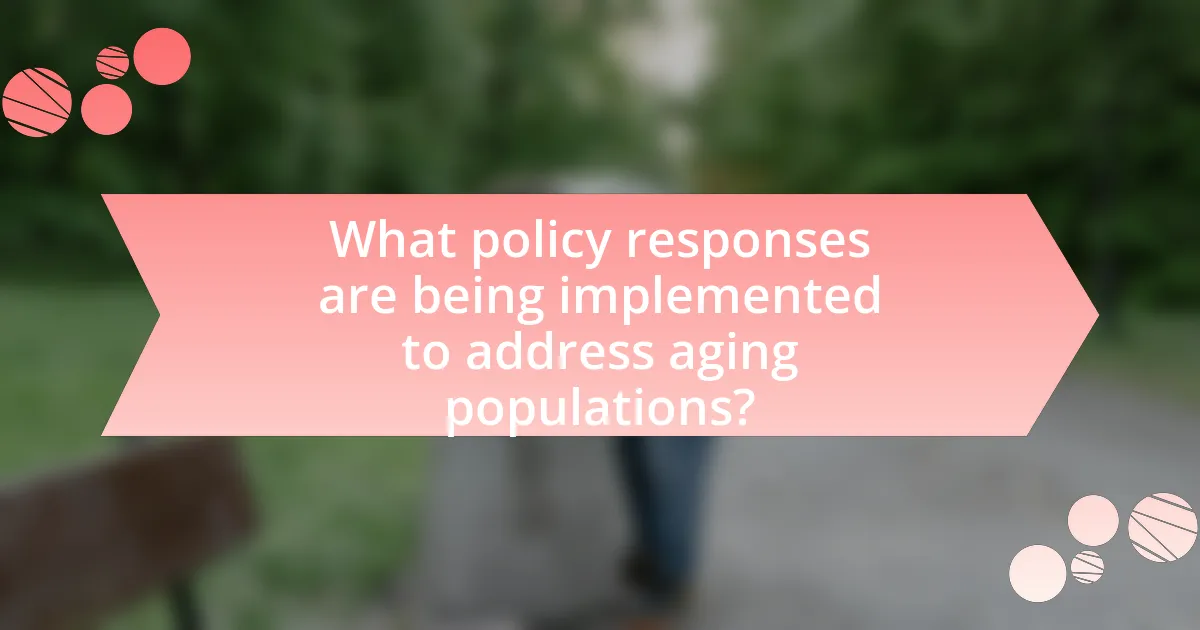The article focuses on understanding policy responses to aging populations, highlighting the key challenges such as increased healthcare costs, a shrinking workforce, and greater demand for social services. It examines the impact of an aging demographic on healthcare systems, including the rising need for chronic disease management and long-term care, as well as the economic implications of a declining working-age population. The article also discusses specific healthcare needs, the financial strain on pension systems, and social challenges like isolation among older adults. Furthermore, it outlines various policy responses being implemented globally, including healthcare reforms, labor market incentives, and community support initiatives aimed at improving the quality of life for seniors.

What are the key challenges posed by aging populations?
The key challenges posed by aging populations include increased healthcare costs, a shrinking workforce, and greater demand for social services. As the proportion of elderly individuals rises, healthcare expenditures are projected to escalate significantly; for instance, the World Health Organization estimates that global healthcare spending could increase by 50% by 2030 due to aging. Additionally, a declining working-age population can lead to labor shortages, which may hinder economic growth and productivity. Furthermore, aging populations often require enhanced social support systems, including pensions and long-term care, placing additional strain on public resources. These challenges necessitate comprehensive policy responses to ensure sustainable economic and social systems.
How does an aging population impact healthcare systems?
An aging population significantly impacts healthcare systems by increasing demand for medical services and long-term care. As the proportion of elderly individuals rises, healthcare systems face greater pressure to provide age-related services, including chronic disease management and rehabilitation. For instance, the World Health Organization reports that individuals aged 65 and older typically have multiple chronic conditions, leading to higher healthcare utilization rates. This demographic shift necessitates adjustments in healthcare policies, workforce planning, and resource allocation to ensure adequate care for the growing elderly population.
What specific healthcare needs arise from an aging population?
The specific healthcare needs that arise from an aging population include increased demand for chronic disease management, mental health services, and long-term care. As individuals age, they are more likely to develop chronic conditions such as diabetes, heart disease, and arthritis, necessitating ongoing medical attention and management strategies. Additionally, mental health issues, including depression and dementia, become more prevalent, requiring specialized mental health services tailored to older adults. Furthermore, the need for long-term care services, including assisted living and nursing home facilities, grows as mobility and independence decline among the elderly. According to the World Health Organization, by 2050, the number of people aged 60 years and older is expected to reach 2 billion, highlighting the urgency of addressing these healthcare needs effectively.
How do healthcare costs change with an aging demographic?
Healthcare costs increase significantly with an aging demographic due to higher prevalence of chronic diseases and increased demand for medical services. As populations age, individuals typically experience more health issues, leading to greater utilization of healthcare resources. For instance, the Centers for Medicare & Medicaid Services reported that per capita spending for individuals aged 65 and older is nearly three times higher than for younger populations. Additionally, older adults often require more frequent hospitalizations, long-term care, and specialized treatments, further driving up costs. This trend is evident in various studies, including a 2020 report from the World Health Organization, which highlighted that healthcare expenditures are expected to rise by 50% in high-income countries by 2030, largely due to aging populations.
What economic implications does an aging population have?
An aging population leads to increased economic burdens on healthcare systems and pension schemes. As the proportion of elderly individuals rises, there is a higher demand for healthcare services, which can strain public health resources and increase government spending. For instance, the World Health Organization estimates that by 2050, the number of people aged 60 years and older will reach 2 billion, significantly impacting healthcare costs. Additionally, a shrinking workforce due to lower birth rates and early retirements can result in reduced economic productivity and slower economic growth. According to the International Monetary Fund, countries with aging populations may experience a decline in GDP growth rates, as seen in Japan, where the aging demographic has contributed to stagnant economic performance over the past two decades.
How does an aging workforce affect productivity?
An aging workforce generally leads to decreased productivity due to factors such as reduced physical stamina, slower adaptation to new technologies, and increased absenteeism. Research indicates that older workers may face challenges in keeping pace with rapid technological advancements, which can hinder overall efficiency. For instance, a study by the McKinsey Global Institute found that productivity growth can slow by 0.5% to 1% annually in industries heavily reliant on manual labor as the workforce ages. Additionally, older employees may experience higher rates of health-related absences, further impacting productivity levels.
What are the implications for pension systems and retirement funding?
The implications for pension systems and retirement funding include increased financial strain due to aging populations, which lead to a higher ratio of retirees to working-age individuals. This demographic shift results in reduced contributions to pension funds while simultaneously increasing the demand for payouts, potentially leading to funding shortfalls. For instance, the United Nations projects that by 2050, the global population aged 60 and older will reach 2.1 billion, significantly impacting the sustainability of pension systems. Additionally, many countries face challenges in adapting their retirement funding models to accommodate longer life expectancies, which can further exacerbate the financial pressures on these systems.
What social challenges are associated with aging populations?
Aging populations face several social challenges, including increased healthcare demands, social isolation, and economic strain on pension systems. As the proportion of elderly individuals rises, healthcare systems experience heightened pressure due to the prevalence of chronic diseases and the need for long-term care, which can lead to increased healthcare costs and resource allocation issues. Social isolation becomes a significant concern as older adults may lose family members or friends, leading to loneliness and mental health issues. Additionally, economic strain occurs as pension systems may struggle to support a growing number of retirees, potentially leading to reduced benefits and increased taxes for the working population. These challenges necessitate comprehensive policy responses to ensure the well-being of aging individuals and the sustainability of social support systems.
How does social isolation affect older adults?
Social isolation negatively impacts older adults by increasing their risk of mental health issues, cognitive decline, and physical health problems. Research indicates that socially isolated seniors experience higher rates of depression and anxiety, with studies showing that approximately 30% of older adults report feelings of loneliness. Additionally, social isolation is linked to a 50% increased risk of dementia, as highlighted in a study published in the journal “Psychological Medicine.” Furthermore, isolated older adults are more likely to have chronic health conditions, leading to a decline in overall well-being and increased healthcare costs.
What role does community support play in addressing aging issues?
Community support plays a crucial role in addressing aging issues by fostering social connections, enhancing mental well-being, and providing essential resources for older adults. Research indicates that strong community ties can reduce feelings of isolation, which is prevalent among the elderly; for instance, a study published in the Journal of Gerontology found that social engagement significantly correlates with improved health outcomes in older populations. Furthermore, community support initiatives, such as local health programs and volunteer networks, offer practical assistance, including transportation and meal delivery, which directly address the daily challenges faced by aging individuals. This multifaceted approach not only improves the quality of life for seniors but also alleviates the burden on healthcare systems by promoting preventive care and active living.

What policy responses are being implemented to address aging populations?
Governments worldwide are implementing various policy responses to address aging populations, including pension reforms, healthcare system adjustments, and labor market participation incentives. Pension reforms often involve raising the retirement age and adjusting benefit formulas to ensure sustainability as life expectancy increases. Healthcare system adjustments focus on expanding access to geriatric care and long-term care services, recognizing the growing demand for age-related health services. Additionally, labor market participation incentives, such as retraining programs and flexible work arrangements, aim to encourage older individuals to remain in the workforce longer, thereby alleviating some economic pressures associated with an aging demographic. These strategies are supported by demographic studies indicating that the proportion of individuals aged 65 and older is projected to rise significantly, necessitating proactive policy measures.
How are governments adapting healthcare policies for older adults?
Governments are adapting healthcare policies for older adults by implementing integrated care models that focus on personalized health services and preventive care. These models aim to enhance accessibility and coordination of care, addressing the unique health challenges faced by aging populations. For instance, countries like Japan and Germany have introduced long-term care insurance systems that provide financial support for home-based and community care services, which are essential for maintaining the independence of older adults. Additionally, the World Health Organization reports that many nations are increasing investments in geriatric training for healthcare professionals to improve the quality of care provided to older adults.
What are the key features of successful aging-related healthcare policies?
Successful aging-related healthcare policies prioritize accessibility, comprehensive care, and preventive services. These policies ensure that older adults have easy access to healthcare facilities and services, which is crucial as studies show that accessibility directly impacts health outcomes. Comprehensive care includes a holistic approach that addresses physical, mental, and social health needs, recognizing that older adults often face multiple health challenges simultaneously. Preventive services, such as regular screenings and vaccinations, are essential in reducing the incidence of chronic diseases, as evidenced by research indicating that preventive care can significantly lower healthcare costs and improve quality of life for seniors.
How do preventive care initiatives impact aging populations?
Preventive care initiatives significantly enhance the health outcomes of aging populations by reducing the incidence of chronic diseases and promoting early detection. These initiatives, such as regular screenings, vaccinations, and health education, lead to improved management of conditions like diabetes and hypertension, which are prevalent in older adults. For instance, studies show that regular health screenings can decrease hospital admissions by up to 30% among seniors, thereby lowering healthcare costs and improving quality of life. Additionally, preventive care fosters healthier lifestyles, which can lead to increased longevity and reduced disability rates in older adults.
What economic policies are being developed to support aging populations?
Economic policies being developed to support aging populations include pension reforms, healthcare funding adjustments, and labor market participation incentives. Pension reforms aim to ensure the sustainability of retirement systems by increasing the retirement age and adjusting benefit formulas to reflect longer life expectancies. Healthcare funding adjustments focus on expanding access to affordable healthcare services for older adults, addressing the rising costs associated with chronic conditions prevalent in this demographic. Labor market participation incentives encourage older individuals to remain in the workforce through tax benefits, flexible work arrangements, and retraining programs, thereby enhancing economic productivity and reducing the financial burden on social security systems. These policies are essential as they respond to the demographic shift towards an aging population, which is projected to reach 1.5 billion people aged 65 and older by 2050, according to the United Nations.
How do tax incentives support families caring for elderly members?
Tax incentives support families caring for elderly members by providing financial relief that can offset caregiving costs. These incentives often come in the form of tax credits or deductions for expenses related to the care of elderly relatives, such as medical expenses, home modifications, or caregiving services. For instance, the IRS allows taxpayers to claim a dependent care credit for qualifying expenses incurred while caring for a dependent, which can significantly reduce the overall tax burden. Additionally, some states offer specific tax breaks for caregivers, further alleviating financial pressures. This financial support encourages families to take on caregiving responsibilities, thereby promoting the well-being of elderly individuals while also easing the economic strain on families.
What role do employment policies play in accommodating older workers?
Employment policies play a crucial role in accommodating older workers by promoting age diversity and ensuring equitable treatment in the workplace. These policies can include flexible work arrangements, anti-discrimination laws, and targeted training programs that address the unique needs of older employees. For instance, the Age Discrimination in Employment Act (ADEA) in the United States protects workers aged 40 and older from discrimination, thereby fostering an inclusive environment. Additionally, research from the World Health Organization indicates that age-friendly workplace policies can enhance productivity and retention rates among older workers, demonstrating the effectiveness of such policies in supporting this demographic.
What social policies are being introduced to enhance the quality of life for older adults?
Social policies being introduced to enhance the quality of life for older adults include increased funding for healthcare services, improved access to affordable housing, and the implementation of social support programs. These policies aim to address the specific needs of older adults, such as chronic health conditions and social isolation. For instance, the expansion of Medicare and Medicaid services has been shown to improve health outcomes for older adults by providing necessary medical care. Additionally, initiatives like the Older Americans Act support nutrition programs and community services, which have been linked to better mental and physical health among seniors.
How do housing policies address the needs of an aging population?
Housing policies address the needs of an aging population by promoting accessible, affordable, and supportive living environments. These policies often include the development of age-friendly housing options, such as single-story homes, assisted living facilities, and modifications to existing homes to accommodate mobility challenges. For instance, the U.S. Department of Housing and Urban Development (HUD) has initiatives that provide funding for home modifications and the construction of accessible units, which are essential for seniors who may have physical limitations. Additionally, policies may incentivize the creation of mixed-use developments that allow older adults to live independently while having access to essential services and social activities nearby, thereby enhancing their quality of life.
What community programs are effective in reducing isolation among seniors?
Community programs that effectively reduce isolation among seniors include senior centers, meal delivery services, and social engagement initiatives. Senior centers provide a space for social interaction, offering activities such as classes, games, and events that foster community connections. Meal delivery services, like Meals on Wheels, not only ensure nutritional needs are met but also provide regular social contact with volunteers. Social engagement initiatives, such as community gardening or technology training programs, encourage seniors to participate actively in their communities, enhancing their social networks. Research indicates that participation in these programs significantly lowers feelings of loneliness and improves overall well-being among older adults.

How can stakeholders effectively collaborate to improve policy responses to aging populations?
Stakeholders can effectively collaborate to improve policy responses to aging populations by establishing multi-sector partnerships that integrate healthcare, social services, and community organizations. These partnerships facilitate the sharing of resources, expertise, and data, which enhances the development of comprehensive policies tailored to the needs of older adults. For instance, the World Health Organization emphasizes the importance of collaborative frameworks in its Global Strategy and Action Plan on Ageing and Health, highlighting that coordinated efforts can lead to better health outcomes and increased quality of life for seniors. By leveraging diverse perspectives and aligning goals, stakeholders can create more effective and sustainable policy solutions that address the complexities of aging populations.
What role do non-governmental organizations play in shaping aging policies?
Non-governmental organizations (NGOs) play a crucial role in shaping aging policies by advocating for the rights and needs of older adults. They influence policy through research, public awareness campaigns, and direct engagement with policymakers. For instance, organizations like AARP in the United States have successfully lobbied for legislation that enhances healthcare access and social security benefits for seniors. Additionally, NGOs often provide valuable data and insights that inform government strategies, ensuring that aging policies are evidence-based and responsive to the actual needs of the aging population. Their involvement is essential in promoting inclusive policies that address the diverse challenges faced by older adults.
How can NGOs partner with governments to enhance service delivery?
NGOs can partner with governments to enhance service delivery by leveraging their expertise in community engagement and resource mobilization. This collaboration allows NGOs to implement targeted programs that address specific needs of aging populations, such as healthcare services, social support, and accessibility initiatives. For instance, a study by the World Health Organization highlights that partnerships between NGOs and governments can lead to improved health outcomes for older adults through joint initiatives that combine resources and knowledge. By sharing data and best practices, both entities can create more effective policies and programs tailored to the unique challenges faced by aging populations.
What best practices exist for collaboration between public and private sectors?
Best practices for collaboration between public and private sectors include establishing clear communication channels, creating joint task forces, and aligning objectives to ensure mutual benefits. Clear communication fosters transparency and trust, which are essential for effective partnerships. Joint task forces enable the pooling of resources and expertise, facilitating innovative solutions to complex issues. Aligning objectives ensures that both sectors work towards common goals, enhancing the impact of initiatives. For instance, the World Economic Forum’s report on public-private partnerships highlights successful collaborations in healthcare that address aging populations, demonstrating the effectiveness of these practices in real-world scenarios.
How can community engagement improve policy effectiveness for aging populations?
Community engagement can significantly improve policy effectiveness for aging populations by ensuring that policies are tailored to the actual needs and preferences of older adults. Engaging community members allows policymakers to gather valuable insights directly from the aging population, leading to more relevant and effective interventions. For instance, studies have shown that when older adults participate in the planning and implementation of health and social services, the resulting programs are more likely to address their specific challenges, such as mobility, healthcare access, and social isolation. This participatory approach not only enhances the relevance of policies but also fosters a sense of ownership among older adults, which can lead to higher utilization rates and better outcomes.
What strategies can be employed to involve older adults in policy development?
To involve older adults in policy development, strategies such as participatory research, focus groups, and advisory councils can be employed. Participatory research engages older adults directly in the research process, ensuring their perspectives shape policy decisions. Focus groups provide a platform for older adults to express their needs and preferences, facilitating dialogue between policymakers and the community. Advisory councils, composed of older adults, can offer ongoing insights and recommendations, ensuring that policies reflect their experiences and challenges. Evidence from the National Institute on Aging indicates that inclusive approaches lead to more effective and relevant policy outcomes for aging populations.
How does public awareness influence policy changes for aging populations?
Public awareness significantly influences policy changes for aging populations by shaping public opinion and driving political agendas. When communities are informed about the challenges faced by older adults, such as healthcare access and social isolation, they are more likely to advocate for policies that address these issues. For instance, a study by the AARP found that increased public awareness campaigns about elder care led to legislative changes in several states, resulting in improved funding for senior services. This demonstrates that heightened awareness can mobilize citizens and policymakers alike, ultimately leading to more responsive and effective aging policies.
What are the best practices for implementing effective aging policies?
The best practices for implementing effective aging policies include promoting active aging, ensuring access to healthcare, and fostering intergenerational solidarity. Active aging encourages older adults to participate in social, economic, and civic activities, which has been shown to improve their quality of life and reduce healthcare costs. Access to healthcare is critical; studies indicate that older adults with regular medical care experience better health outcomes and lower hospitalization rates. Additionally, fostering intergenerational solidarity helps bridge the gap between age groups, enhancing community cohesion and support systems. These practices are supported by evidence from various countries that have successfully integrated aging policies into their social frameworks, demonstrating improved outcomes for older populations.
How can data and research inform better policy decisions for aging populations?
Data and research can inform better policy decisions for aging populations by providing evidence-based insights into their needs and challenges. For instance, demographic studies reveal that by 2030, one in five Americans will be over 65, highlighting the necessity for policies that address healthcare, social services, and economic support tailored to this demographic. Research from the National Institute on Aging indicates that effective interventions, such as community-based programs, can improve health outcomes and reduce costs. Additionally, data analytics can identify trends in aging-related issues, enabling policymakers to allocate resources efficiently and design targeted programs that enhance the quality of life for older adults.
What lessons can be learned from successful aging policy initiatives worldwide?
Successful aging policy initiatives worldwide demonstrate the importance of comprehensive, inclusive approaches that prioritize health, social engagement, and economic security for older adults. For instance, countries like Japan have implemented community-based care models that emphasize preventive health measures and social participation, resulting in improved quality of life and reduced healthcare costs. Additionally, Sweden’s pension system, which combines public and private elements, ensures financial stability for retirees, showcasing the effectiveness of diversified funding sources. These examples highlight that successful aging policies must be adaptable, culturally relevant, and focused on empowering older individuals to maintain their independence and well-being.
